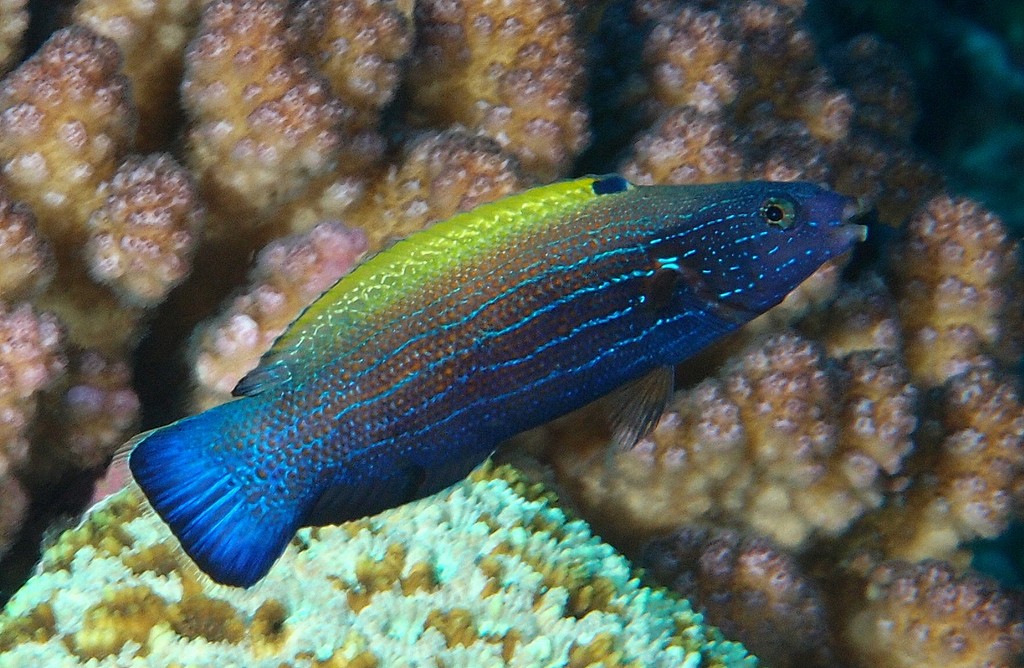LABROPSIS XANTHONOTA - (RANDALL, 1981)
Actinopterygii (Gigaclass) > Actinopteri (Class) > Teleostei (Subclass) > Labriformes (Order) > Labroidei (Suborder) > Labridae (Family) > Labropsis (Genus)
Blacklobe wrasse, V-tail tubelip wrasse, V-tail wrasse, Wedge-tailed wrasse, Yellowback tubelip, Yellowback tubelip wrasse, Miyakebera, ミヤケベラ, 单线黑隆鱼,
Synonyme
Labrichthys xanthonota (Randall, 1981)
-------------------------
Description
Dorsal spines (total): 9; Dorsal soft rays (total): 11; Anal spines: 3; Anal soft rays: 10; Pectoral fin rays: 14-15 (usually: 14) Lateral line scales: 46-49 (+2 past hypural). Postorbital head and posterior suborbital with small scales (none extending anterior to centre of eye); Lips thick and fleshy, forming a tube when mouth closed; Front upper jaw with two pairs of large recurved canine teeth, the second pair about half as long as first, and a large canine posteriorly, with no teeth between; Front lower jaw with a pair of large recurved canines, followed by 2-3 lesser canines. No free lower preopercular margin; Body depth: 3.4-3.8 in SL; Caudal fin of juveniles rounded, of females truncate with rounded corners, of males emarginate; Pelvic fins short, not reaching anus. Max. length: 13.0 cm TL. Depth range: 7 - 55 m.
Color
Juveniles are black with several white pinstripes; Females become lighter dorsally, and males develop golden centered scales, blue lines on the face, and a wedge-shaped white area in the center of the tail.
Etymology
Labropsis: from Latin, Labrum = lip + from Ancient Greek, óps = eye, face, appearance. Referring to similarity to Labrichthys and Labroides.
xanthonota: from ancient Greek, xanthós = yellow + from Latin, nota = mark, sign. Referring to yellow of upper back and dorsal fin of females, its most conspicuous color marking underwater.
Original description:
Distribution
Indo-West Pacific: East Africa, Madagascar, Seychelles and western Mascarenes (La Réunion, Mauritius) east to Micronesia, Samoa and Tonga, north to Japan and Ogasawara Islands (Japan), south to northern Australia and Loyalty Islands (New Caledonia).
Biology
Uncommon inhabitant of coral-rich areas of clear outer lagoon and seaward reefs. May form small groups. Males generally solitary. Juveniles are cleaners while adults feed on coral polyps. This species is collected for the aquarium trade.
Last update: 17, March 2023
Blacklobe wrasse, V-tail tubelip wrasse, V-tail wrasse, Wedge-tailed wrasse, Yellowback tubelip, Yellowback tubelip wrasse, Miyakebera, ミヤケベラ, 单线黑隆鱼,
Synonyme
Labrichthys xanthonota (Randall, 1981)
-------------------------
Description
Dorsal spines (total): 9; Dorsal soft rays (total): 11; Anal spines: 3; Anal soft rays: 10; Pectoral fin rays: 14-15 (usually: 14) Lateral line scales: 46-49 (+2 past hypural). Postorbital head and posterior suborbital with small scales (none extending anterior to centre of eye); Lips thick and fleshy, forming a tube when mouth closed; Front upper jaw with two pairs of large recurved canine teeth, the second pair about half as long as first, and a large canine posteriorly, with no teeth between; Front lower jaw with a pair of large recurved canines, followed by 2-3 lesser canines. No free lower preopercular margin; Body depth: 3.4-3.8 in SL; Caudal fin of juveniles rounded, of females truncate with rounded corners, of males emarginate; Pelvic fins short, not reaching anus. Max. length: 13.0 cm TL. Depth range: 7 - 55 m.
Color
Juveniles are black with several white pinstripes; Females become lighter dorsally, and males develop golden centered scales, blue lines on the face, and a wedge-shaped white area in the center of the tail.
Etymology
Labropsis: from Latin, Labrum = lip + from Ancient Greek, óps = eye, face, appearance. Referring to similarity to Labrichthys and Labroides.
xanthonota: from ancient Greek, xanthós = yellow + from Latin, nota = mark, sign. Referring to yellow of upper back and dorsal fin of females, its most conspicuous color marking underwater.
Original description:
Distribution
Indo-West Pacific: East Africa, Madagascar, Seychelles and western Mascarenes (La Réunion, Mauritius) east to Micronesia, Samoa and Tonga, north to Japan and Ogasawara Islands (Japan), south to northern Australia and Loyalty Islands (New Caledonia).
Biology
Uncommon inhabitant of coral-rich areas of clear outer lagoon and seaward reefs. May form small groups. Males generally solitary. Juveniles are cleaners while adults feed on coral polyps. This species is collected for the aquarium trade.
Last update: 17, March 2023
